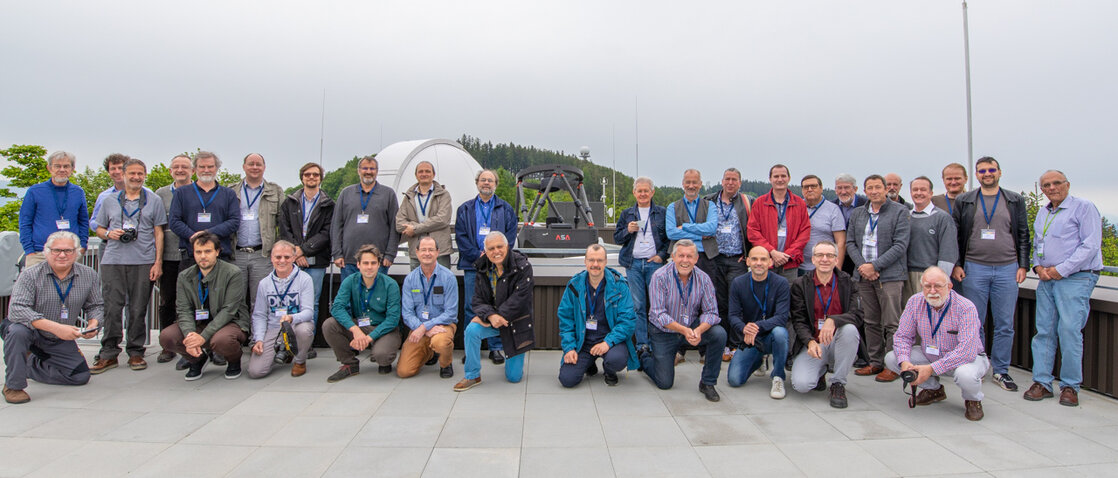VEGA 2019
International Spectroscopy Symposium for Amateurs May 30 - June 1, 2019
A very successful conference with interesting lectures and discussions.
This conference takes place in a unique facility in Europe, the Vega Observatory in Haunsberg near Salzburg / Austria.
2019 was the first time this symposium took place, and it was a great success. Lectures by a large number of professional and amateur astronomers gave a deep insight into current research in astrophysics and spectroscopy, as well as ongoing and future ProAm collaborations.
The conference language was in English. There were participants from 13 countries, 3 continents.

May 30
Manfred Schwarz: Conference opening

Herbert Pühringer: The way to the VEGA Observatory

Herbert told the fantastic story about the origin of the Haunsberg Observatory, from the idea to the financing, to the construction.
He also reported on the student project, the construction of a spectrograph and the public relations work at the observatory.
Prof. Dr. Paolo Sereni [University of Salzburg]: Spectroscopy projects with students

Paolo and his students jointly develop electronics and software based on Aduino and Raspberry Pi to control the self-built spectrograph. The cooperation of the university with the observatory proved to be a fruitful collaboration for both sides.
Prof. Dr. Ph. Bennett [Dalhousie University, Halifax, NS, Canada]: Two Decades of Observations of the Eclipsing Red Supergiant Binary VV Cephei

Phil spoke about the historical and current research of the binary system vv Cephei. This star is also the subject of a long-term monitoring project of amateurs. Particularly interesting findings are obtained in the time of the eclipse, every 20.34 years.
Manfred Schwarz: SpectroCalc - Tools and Workflow

Manfred presented his new spectra reduction software. It builds up the complete workflow from the exposed images to the final reduced spectrum. It is user friendly with short steps in the reduction process..
Prof. Dr. Ph. Bennett [Dalhousie University, Halifax, NS, Canada]: The Enigmatic Yellow Supergiant Binary Epsilon Aurigae

Martin Dubs: Calibration of meteor spectra

It sounds impossible, but it works! Martin has imaged spectra of meteors sfor many yearse. He explained the process of how to obtain images and spectra of meteors.
May 31
Prof. Dr. Gerald Handler [Nicolaus Copernicus Center Warsaw]: The interiors of massive stars as seen with the space missions BRITE & TESS

Gerald discussed the satellite missions of BRITE and TESS, and talked about the methods for determining nonradial pulsations of stellar surfaces.
Prof. Dr. Anatoly Miroshnichenko [(University of North Carolina/Greensboro]: Long term spectral variations of selected bright Be stars and binarity

Based on many examples of Be stars, which are also accessible to us amateurs, Anatoly explained the phenomena of these extraordinary stars. He also invited amateurs to collaborate in several ProAm projects.
Dr. Reinhard Hanuschik (ESO): Present and future of spectroscopy at ESO

It was extremely interesting to look behind the scenes of ESO. Reinhard gave us the insight into the technology of the professional European observatories.
Roman Gümperlein MSc : Method for automated wavelength calibration of spectra via robust pattern recognition

Roman talked about his own developed search algorithm for reference lines, and provided his results for the integration into the amateurs software environment.
Prof. Dr. Anatoly Miroshnichenko [(University of North Carolina/Greensboro]: The nature and evolutionary state of dust making objects with the B[e] phenomenon

Circumstellar matter in binary systems and the connection to B[e] stars, a highly interesting theme also for amateurs.
Gerado Avila & Carlos Guirao: Presentation of the prototype of our latest fiber linked echelle spectrograph: requirements, performance and results

Gerado and Carlos showed the techniques for different types of spectrographs and presented their new concept of the WHAPOS Echelle spectrograph.
June 1
Thilo Bauer: Spectrophotometry of Gaseous Nebulae

A very difficult but interesting field for amateurs is the spectroscopy of gaseous nebulas. Thilo reported on his experiences and the physical background of emission lines in gaseous nebulas.
Ernst Pollmann: The precession of Pleiones disk

Ernst presented us with the results of long-term monitoring of the star Pleione and the interpretation of line profiles in relation to a gas disk.
Martin Sblewski: Reduction and calibration of spectra with Midas

Martin talked about his self-made spectrograph, and about the possibility to use Midas software in a simple way for spectral reduction with free available scripts.
Ernst Pollmann: Hα profile observations of the Be star ζ Tauri

Ernst discussed the latest results about the long-term monitoring of ζ Tauri.
François Cochard: The most interesting spectroscopic instrumentation in amateur spectroscopy

François talked about the basics of a spectrograph, the different variants for amateurs and the main things to look for.
Sideshows
Hotel Ammerhauser

Excellent service and pleasant ambience.
Lunch in the restaurant Kaiserbuche

Good food and wonderful views of the surrounding mountains.
Vega Observatory


The 1m ASA EQ 1000 RC F7 equatorial telescope


